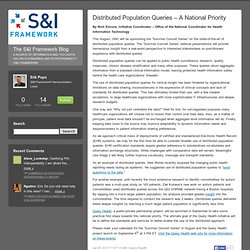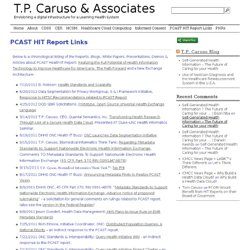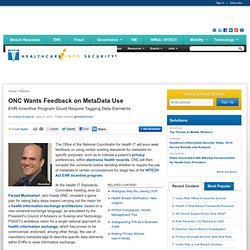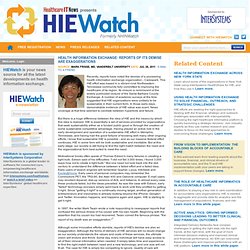

Health Data Exchange Market Is Changing. Mycourses.med.harvard.edu/ec_res/nt/0DF6DC6D-CE3E-457F-A522-42CDBAFCA93E/hie_casestudy.pdf. Mycourses.med.harvard.edu/ec_res/nt/8B2A09F4-4EC8-429D-998A-3BC96EC149FE/hie_model.pdf. Mycourses.med.harvard.edu//ec_res/nt/FEAFD83A-21D8-4DC4-9303-4E34C06E21CD/hie_summary.pdf. Distributed population queries – a national priority. By Rich Elmore, Initiative Coordinator – Office of the National Coordinator for Health Information Technology This August, ONC will be sponsoring the “Summer Concert Series” on the state-of-the-art of distributed population queries.

The “Summer Concert Series” webinar presentations will provide tremendous insight from a real-world perspective to interested stakeholders on practitioners’ experience with distributed queries. Distributed population queries can be applied to public health surveillance, research, quality measures, chronic disease stratification and many other purposes.
These queries return aggregate information from a standard clinical information model, leaving protected health information safely behind the health care organizations’ firewalls. PCAST & NEA – T.P. Caruso & Associates* Below is a chronological listing of the Reports, Blogs, White Papers, Presentations, Demos & Articles about PCAST Health IT Report: Realizing the Full Potential of Health Information Technology to Improve Healthcare for Americans: The Path Forward and a New Exchange Architecture: 7/10/2012 B.

Robson: Health Standards and Scalability 6/20/2012 Data Segmentation for Privacy Workgroup, S & I Framework Initiative, Response to HITSC Recommendations related to PCAST Report 4/25/2012 DOD SBIR Solicitations: Prototype, Open Source Universal Health Exchange Language. ONC Wants Feedback on MetaData Use. EHR Incentive Program Could Require Tagging Data Elements The Office of the National Coordinator for Health IT will soon seek feedback on using certain existing standards for metadata for specific purposes, such as to indicate a patient's privacy preferences, within electronic health records.

ONC will then consider the comments before deciding whether to require the use of metadata in certain circumstances for stage two of the HITECH Act EHR incentive program. At the Health IT Standards Committee meeting June 22, Farzad Mostashari, who heads ONC, revealed a game plan for taking baby steps toward carrying out the vision for a health information exchange architecture, based on a new universal exchange language, as articulated by the President's Council of Advisors on Science and Technology. Earlier, a workgroup that reviewed the PCAST report recommended that ONC take a go-slow approach to testing the council's recommendations (see: Tests of New HIE Architecture Slated). Survey: HIE Patient Consent Evolving. More Networks Offering More Granular Consent More organizations that run health information exchanges are offering patients the opportunity to provide more specific levels of consent for the exchange of their records, a new survey by the advocacy group eHealth Initiative shows.
Rather than simply asking patients to indicate approval for exchange of all information in all circumstances, some HIEs are offering more granular consent. For example, 56 percent of the 196 HIE operators surveyed said they offer patients the opportunity to decide which providers can have access to their data, up from 43 percent last year. Of those that offer this level of consent, 64 percent provide it using the opt-out model, while 36 percent use the opt-in model.
In the opt-out model, patients' data is automatically available for exchange unless individuals choose to withdraw their permission. Health information exchange: Reports of its demise are exaggerations. E-mail to a Friend Recently, reports have noted the demise of a pioneering health information exchange organization - Carespark.

This HIE effort was based in a vibrant rural Northeastern Tennessee community fully committed to improving the healthcare of its region. Its closure is reminiscent of the widely publicized closure of the Santa Barbara County Exchange. A number of academic surveys at the time suggested that HIE organizations were unlikely to be sustainable in their current form. In those early days, demonstrable evidence of HIE value was scant. But there is a huge difference between the idea of HIE and the means by which this idea is realized. In 1897, the writer Mark Twain wrote a note responding to newspaper reports that confused the serious illness of his cousin with his own health. Although some innovative efforts stumble, reports of HIE's demise are also an exaggeration. 1. Health information exchanges are vital to pandemic responses, official says. HIE- the evolution of an idea. New Exchange Architecture – T.P. Caruso & Associates*
One of my Self-Generated Health Information Consortium Steering Committee members introduced me to the concept of a health record bank (HRB, though I have been thinking along these lines for awhile now as reflected in my “Transforming Health Research through Use of a Secure Health Data Cloud” presentation made in December 2011 in Saudi Arabia as part of my efforts to develop Quantal Semantics, Inc.).

My investigation of this concept led me to the Health Record Banking Alliance as well as HRB business model and HRB architecture white papers about this concept for health information exchange. I followed up with Bill Yasnoff the founder of the HRB Alliance and he has been very generous with his time to explain HRBs as well as a specific business plan for moving forward with an HRB.
Health information exchanges are vital to pandemic responses, official says. T.P. Caruso & Associates*